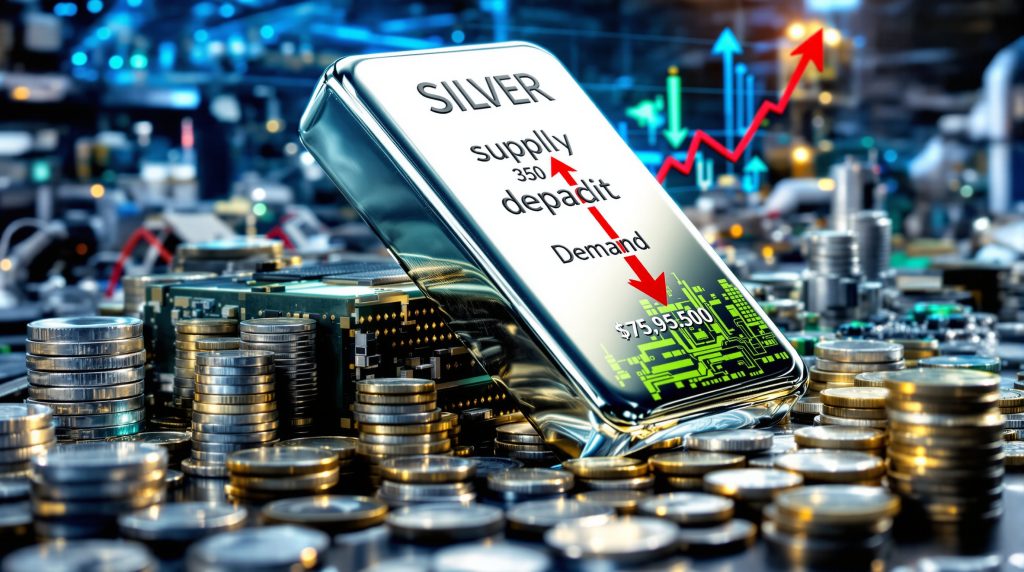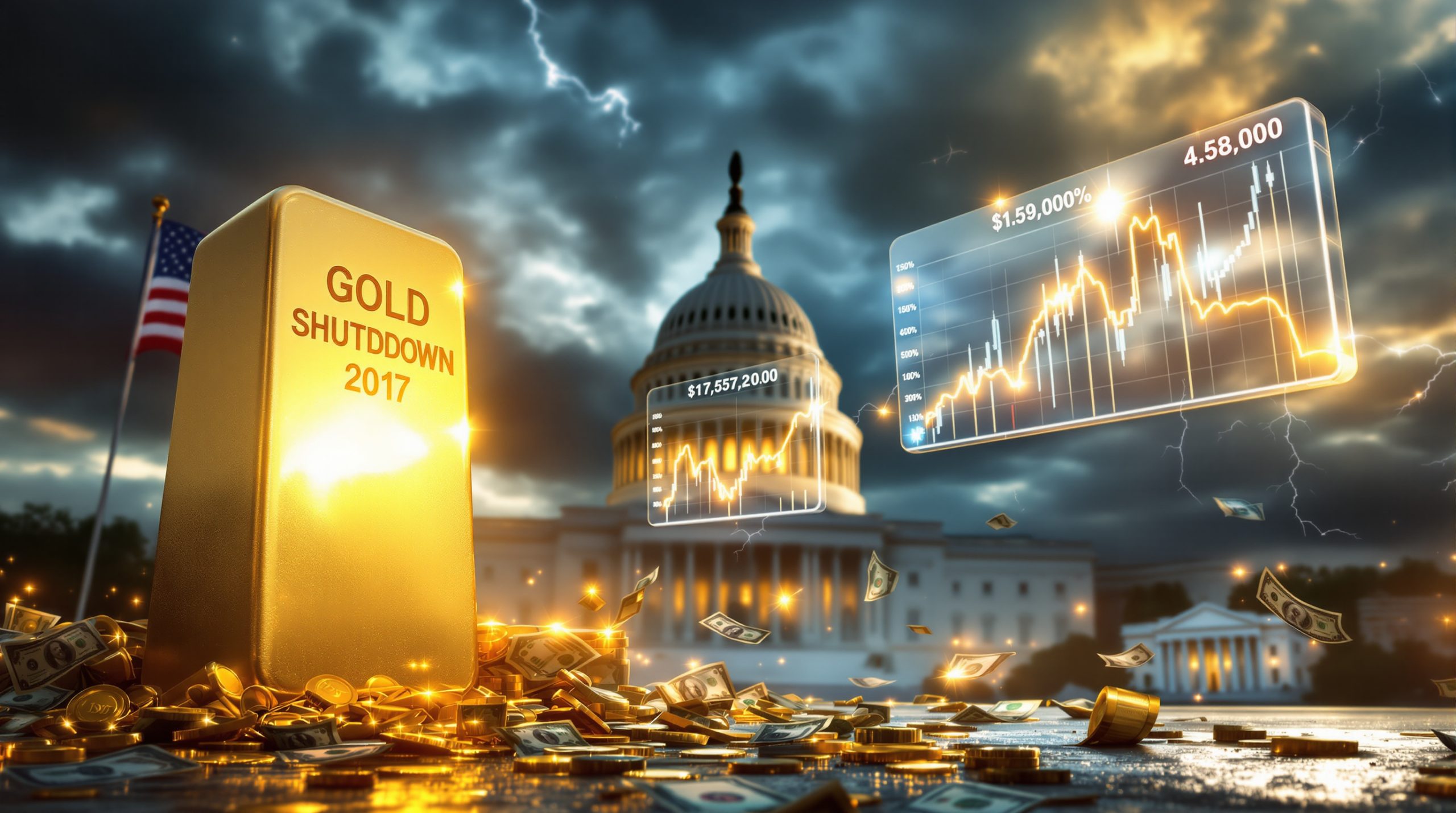Silver Supply Deficit: The Growing Gap Between Demand and Production
The global silver market is experiencing a persistent structural deficit, with demand consistently outpacing supply by a significant margin. This imbalance has been ongoing for several years, creating market pressure and notable price implications for investors and industry participants alike.
Understanding the Current Deficit
Recent market analysis reveals that silver demand exceeds supply by approximately 200-250 million ounces annually. This substantial gap represents roughly 20-25% of total annual production, creating a sustained drawdown of above-ground inventories. The cumulative deficit over the past five years has approached 800 million ounces, significantly tightening physical availability.
One telling indicator of this tightness can be seen in lease rates. Typically, silver lease rates hover around 1-2%, but in the first half of 2024, these rates jumped to 7% – a clear sign of growing physical supply constraints.
Despite this ongoing deficit, silver remains the only major commodity still trading below its 1980 nominal price high of approximately $50 per ounce. When adjusted for inflation, that historical silver performance would equate to roughly $150 in today's dollars—highlighting the potential for significant price appreciation as market fundamentals continue to assert themselves.
How Silver Supply Functions
Understanding the supply dynamics of silver reveals why production cannot easily adjust to meet rising demand, creating a structural rigidity that perpetuates the deficit.
Primary vs. Byproduct Production
The most critical aspect of silver supply is that approximately 75% comes as a byproduct from other mining operations:
| Silver Source | Percentage of Global Supply |
|---|---|
| Primary silver mines | 25% |
| Byproduct from other mining | 75% |
This production structure means that even with higher silver prices, supply cannot quickly respond since the economics of the primary metal (copper, lead, zinc, or gold) drive production decisions.
As one industry expert puts it: "If I need more silver for tomahawk missiles, electric vehicle batteries, or solar panels, I need to convince copper, lead, zinc, or gold miners to increase production because that's where 75% of the metal comes from."
Mining Production Constraints
Several factors limit the ability to increase silver production:
-
Permitting challenges: Many jurisdictions have implemented stricter environmental regulations, particularly regarding open-pit mining, which accounts for 70% of Mexico's silver production (the world's largest producer).
-
Capital intensity: New mining projects require billions in investment and decades of development time. Recent data suggests a new major copper discovery (which would produce silver as a byproduct) can take three decades and potentially $10 billion in investment to bring online.
-
Social license concerns: Community opposition represents a significant barrier to developing new mines. Two of the world's largest undeveloped silver projects, located in Central and South America, face significant community resistance issues.
-
Water scarcity: Many potential mining regions face critical water access issues, limiting development potential for water-intensive mining operations.
Limited Recycling Capacity
Recycling contributes approximately 150 million ounces annually to silver supply. However, unlike gold, much of the silver used in industrial applications is dispersed in tiny amounts across billions of products, making recovery economically challenging.
The concentration of silver in many electronic products is so minimal that recovery costs often exceed the value of the metal itself, limiting recycling's ability to significantly address the silver supply deficits drivers.
Accelerating Silver Demand
Silver demand continues to accelerate across multiple sectors, creating persistent pressure on available supply and widening the silver supply demand deficit.
Industrial Applications Driving Growth
Industrial demand now accounts for over 50% of total silver consumption, compared to just 10% a century ago. This shift reflects silver's unique properties and expanding applications:
-
Electrical conductivity: Silver is the most conductive element on the planet, making it essential for high-performance electronics and miniaturized devices.
-
Antimicrobial properties: Silver's ability to destroy bacteria drives applications in medical settings, water purification, and consumer products.
-
Thermal conductivity: Silver efficiently transfers heat, critical for many industrial processes and thermal management systems.
Green Energy Transition
The renewable energy transition represents a major driver of silver demand growth:
-
Solar photovoltaics: Each solar panel requires silver for electrical connections and conductors. As global solar capacity continues to expand under renewable energy mandates, silver demand from this sector is projected to increase significantly.
-
Electric vehicles: The average EV contains more silver than conventional vehicles, primarily in electrical systems and battery management. As automotive manufacturers accelerate EV production, silver demand from this sector will grow accordingly.
Military and Advanced Technology
Silver's role in defense applications and advanced technologies continues to expand:
-
Missile systems: Modern defense systems require silver for reliable electrical connections that can withstand extreme conditions.
-
5G infrastructure: The rollout of next-generation telecommunications networks demands significant silver inputs for high-performance components.
-
Electronics miniaturization: As devices become smaller and more powerful, silver's superior conductivity becomes increasingly valuable for maintaining performance while reducing size.
Investment Demand's Critical Role
Beyond industrial applications, monetary and investment demand plays an increasingly important role in the silver market dynamic.
Central Bank and Sovereign Interest
Recent developments indicate growing institutional interest in silver:
-
Russia: Has announced plans to include silver in its precious metals strategy, expanding beyond traditional gold holdings.
-
Saudi Arabia: Has made significant investments in silver-backed exchange-traded products, diversifying their asset allocation.
-
India: Holds substantial silver and gold reserves, reflecting cultural and historical affinity for precious metals. According to industry experts, India actually houses more gold and silver than any other nation.
Retail Investment Patterns
Individual investors continue to demonstrate strong interest in physical silver:
-
Bullion and coin demand: Typically spikes during periods of economic uncertainty, contributing to market tightness.
-
"Silver stacking" community: A dedicated base of physical silver accumulators, predominantly males aged 45-85, who view their holdings as long-term savings rather than tradable assets. These investors are generally resistant to selling, even at higher prices.
Institutional Allocation Shifts
Traditional investment portfolios are beginning to reconsider precious metals allocation:
-
Traditional portfolio models: Typically allocate less than 0.5% to precious metals.
-
Emerging recommendations: Some financial institutions now suggest allocations of up to 20% to precious metals as a hedge against inflation and currency devaluation. Morgan Stanley has reportedly suggested a 60-20-20 portfolio structure (60% equities, 20% bonds, 20% precious metals) rather than the traditional 60-40 split.
Price Discovery Challenges
The persistent deficit raises questions about price discovery and market dynamics, particularly given silver's unique position straddling both industrial and monetary roles.
Technical Price Considerations
Silver faces significant technical price levels that could trigger accelerated moves:
-
Historical resistance at $50: Silver has twice reached but failed to sustain prices above $50 (in 1980 and 2011).
-
Triple top pattern: Technical analysts note that markets rarely form "triple tops," suggesting the next test of the $50 level could lead to a breakthrough rather than another rejection.
Currency Considerations
While silver in US dollars has yet to break historical highs, the picture differs in other currencies:
-
Non-USD currencies: Silver has already reached new all-time highs in euros, Canadian dollars, Australian dollars, and other major currencies.
-
Historical precedent: Gold's 2019 breakout in USD was preceded by new highs in other currencies. This pattern may foreshadow silver's path, as breakouts in alternative currencies often signal an eventual USD breakout.
Momentum and Passive Investment
Market structure has evolved significantly since previous silver bull markets:
-
Passive investment dominance: Over 50% of managed money now flows through passive vehicles that follow momentum and algorithmic signals.
-
Momentum triggers: As silver establishes a clear uptrend, passive investment flows could accelerate price movements beyond fundamental valuations, potentially creating a self-reinforcing cycle.
Investment Options in the Silver Market
Investors seeking exposure to the silver market have multiple options across the risk spectrum, from conservative physical holdings to speculative development companies.
Physical Silver
Direct ownership of silver bullion or coins offers:
-
No counterparty risk: Physical possession eliminates dependency on financial intermediaries.
-
Long-term preservation: Historically maintained purchasing power through currency devaluations.
-
Liquidity: Easily converted to cash in most locations worldwide.
Many physical silver investors view their holdings as intergenerational wealth rather than tradable assets, which helps explain why higher prices don't necessarily trigger significant selling.
Silver Royalty Companies
Companies that finance mining operations in exchange for a percentage of production offer:
-
Diversified exposure: Typically hold rights to multiple mining operations, reducing single-project risk.
-
Reduced operational risk: Not directly exposed to mining cost inflation or operational challenges.
-
Growth potential: Can expand portfolios without significant capital expenditure.
Industry leaders like Wheaton Precious Metals provide substantial silver exposure with the safety of a diversified portfolio of streaming agreements.
Silver Mining Companies
Direct investment in silver producers provides:
-
Operational leverage: Fixed costs mean profits can grow faster than silver price increases.
-
Limited universe: Only approximately 10 primary silver producers exist globally.
-
Jurisdictional considerations: Operations span various regulatory environments with different risk profiles.
Major producers include Pan American Silver (producing approximately 26 million ounces of silver and just under 1 million ounces of gold annually) and Hecla Mining (America's largest silver producer operating in stable jurisdictions).
Silver Development Companies
Companies advancing projects toward production offer:
-
Higher risk/reward profile: Greater potential upside balanced against development uncertainties.
-
Acquisition potential: Often become takeover targets for larger producers seeking to replace reserves.
-
Project quality spectrum: Companies with marginal projects may offer the highest leverage to rising silver prices, as previously uneconomic resources become viable at higher price points.
Long-Term Implications of the Silver Deficit
The persistent supply-demand imbalance has significant implications for various stakeholders, from industrial users to investors and mining companies.
Industrial User Challenges
Companies dependent on silver inputs face increasing challenges:
-
Supply security concerns: Critical industries may need to secure long-term supply agreements to ensure production continuity.
-
Substitution limitations: Silver's unique properties make finding alternatives difficult in many applications, particularly where conductivity is paramount.
-
Cost pressures: Rising input costs may necessitate price increases or margin compression for manufacturers reliant on silver components.
Mining Industry Evolution
The silver mining landscape continues to evolve in response to market conditions:
-
Exploration incentives: Higher sustained prices should eventually stimulate increased exploration activity, though results will lag by years or decades.
-
Project economics: Previously marginal projects become viable at higher price levels, potentially expanding the universe of developable resources.
-
Consolidation potential: Larger companies may acquire smaller producers to secure reserves, particularly as replacement becomes more challenging.
Investment Implications
The ongoing deficit creates various investment considerations:
-
Portfolio diversification: Silver offers potential correlation benefits within broader investment strategies, particularly during periods of market stress.
-
Inflation hedge: Historical performance during inflationary periods suggests protective characteristics that complement traditional assets.
-
Monetary reset protection: Some analysts view silver as potential protection against systemic financial disruptions due to its dual monetary and industrial roles.
The Path Forward for Silver
The silver market stands at a pivotal juncture, with structural deficits creating persistent pressure on available supply. The unique combination of industrial necessity and monetary characteristics positions silver differently from most commodities.
The ongoing silver supply demand deficit of 200-250 million ounces annually represents a fundamental imbalance that appears unlikely to resolve in the near term. Production constraints, expanding industrial applications, and growing investment interest create a compelling case for continued market tightness.
While short-term price movements remain subject to various market forces, the underlying fundamentals suggest the potential for significant price appreciation as physical inventories continue to decline. The silver market squeeze insights further highlight how market dynamics are evolving, while potential tariff impacts on silver could create additional complexity in the market.
For investors, industry participants, and market observers, understanding these dynamics provides valuable context for navigating this unique market environment. Whether silver reaches its inflation-adjusted potential of $150 or moves beyond remains to be seen, but the structural factors driving the deficit appear firmly entrenched for the foreseeable future. Implementing effective silver pricing strategies will be essential for stakeholders across the industry.
Disclaimer: This article is for informational purposes only and does not constitute investment advice. Investing in precious metals and mining companies involves risk, including the potential loss of principal. Past performance is not indicative of future results. Readers should consult with a qualified financial advisor before making investment decisions.
Further Resources
Readers interested in learning more about silver market dynamics can explore additional educational content on platforms like Palisades Gold Radio, which offers in-depth interviews with industry experts discussing factors influencing the silver market. Additionally, the Silver Institute provides comprehensive research and data on global silver supply and demand trends.
Ready to Capitalise on the Next Silver Market Opportunity?
Discovery Alert's proprietary Discovery IQ model instantly identifies significant ASX mineral discoveries, including silver, delivering real-time alerts that help you act before the broader market. Discover why major mineral discoveries can lead to exceptional returns by exploring our dedicated discoveries page.




